
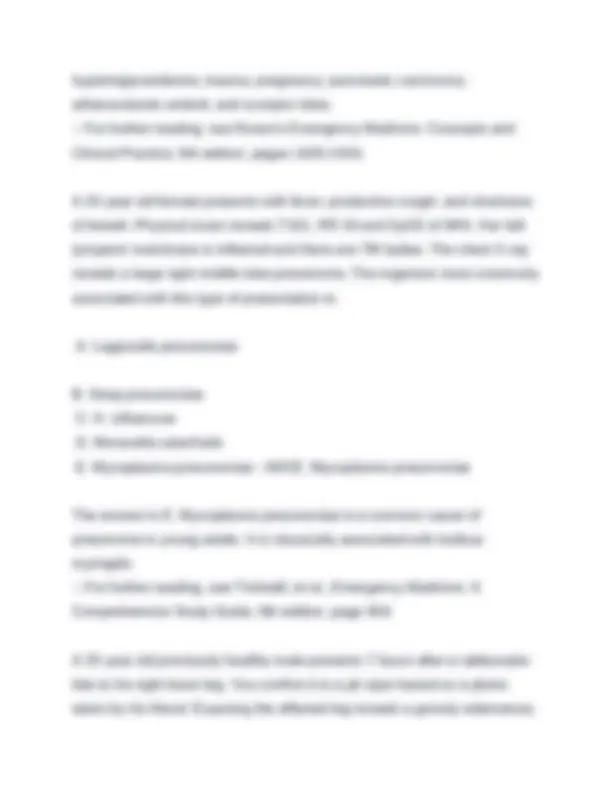
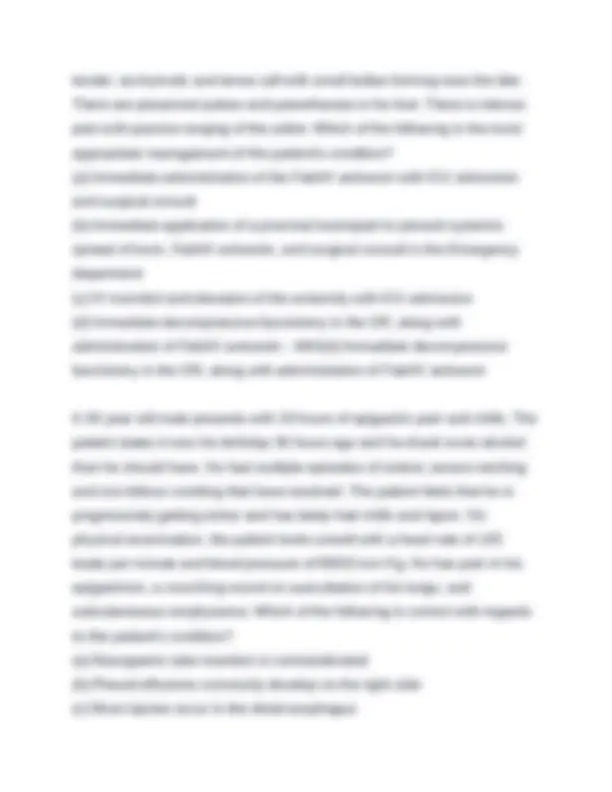
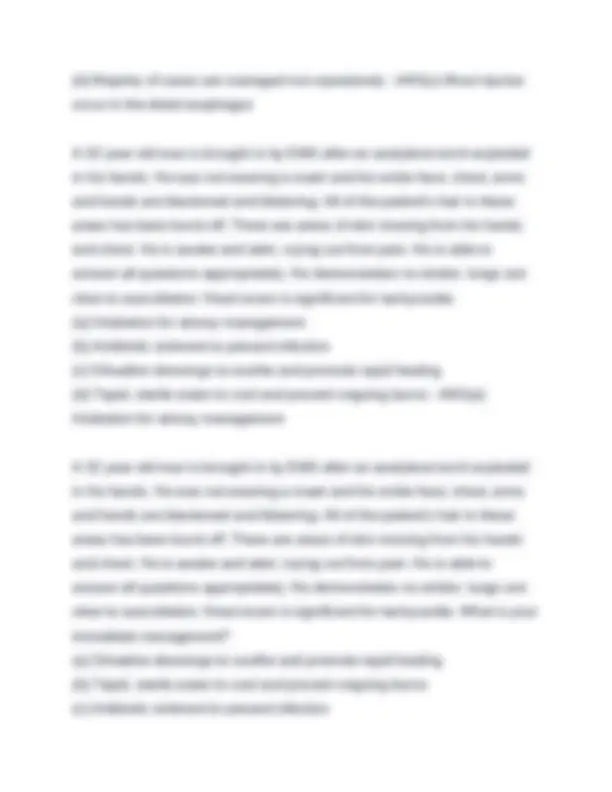
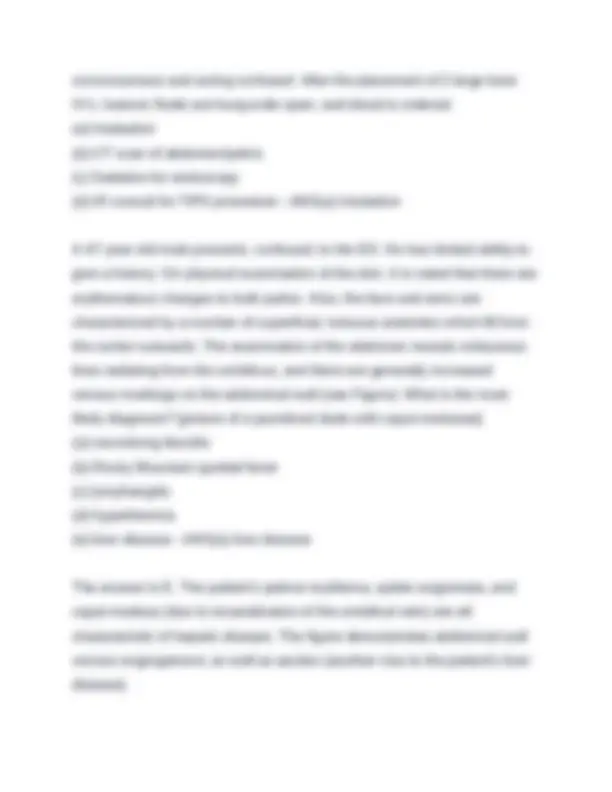
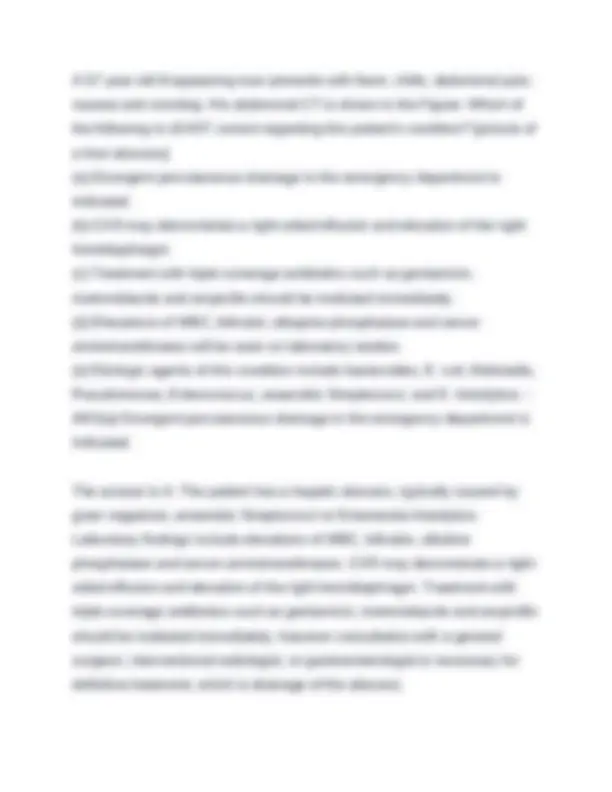
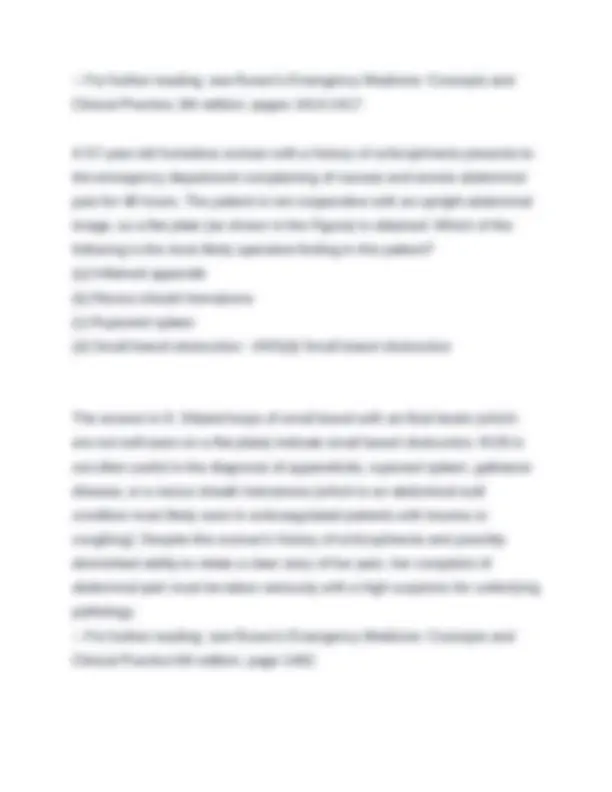
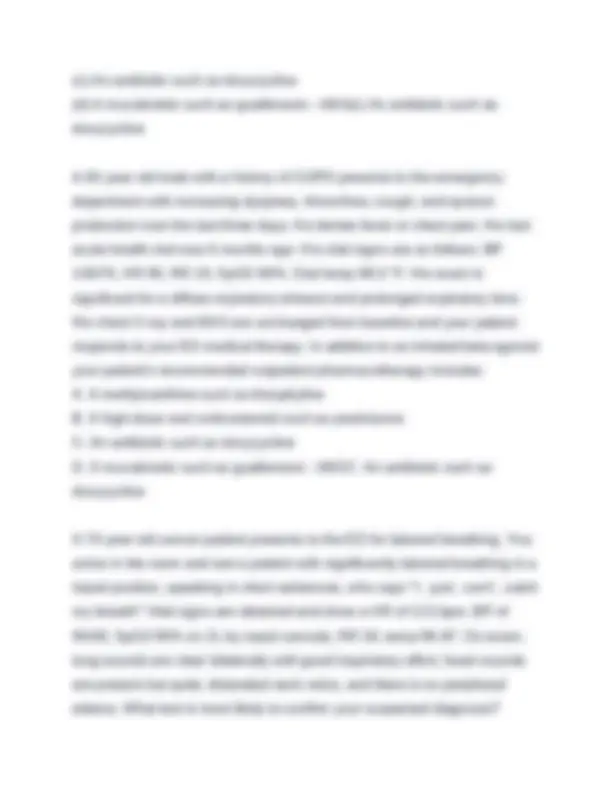
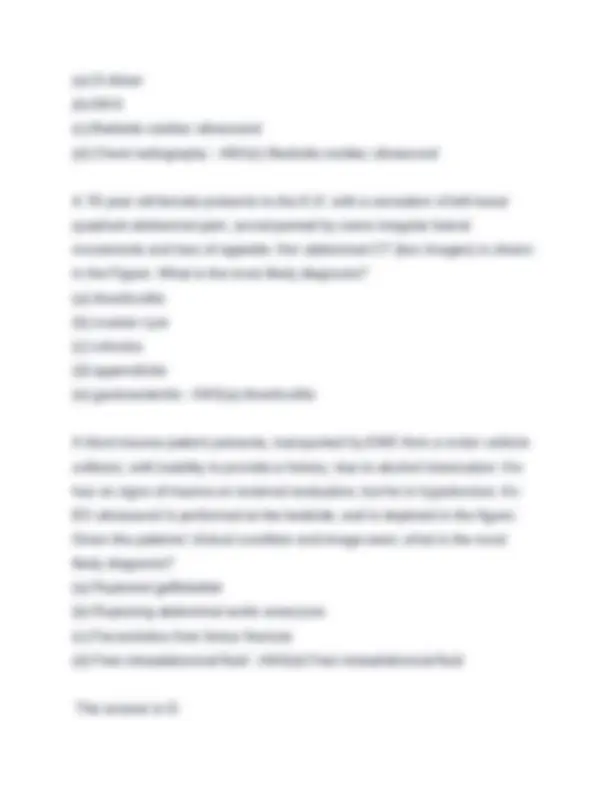

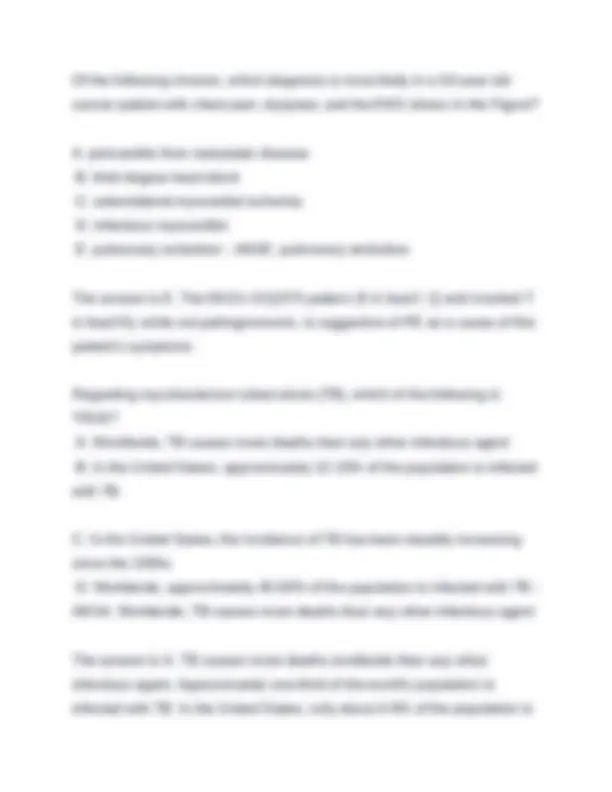
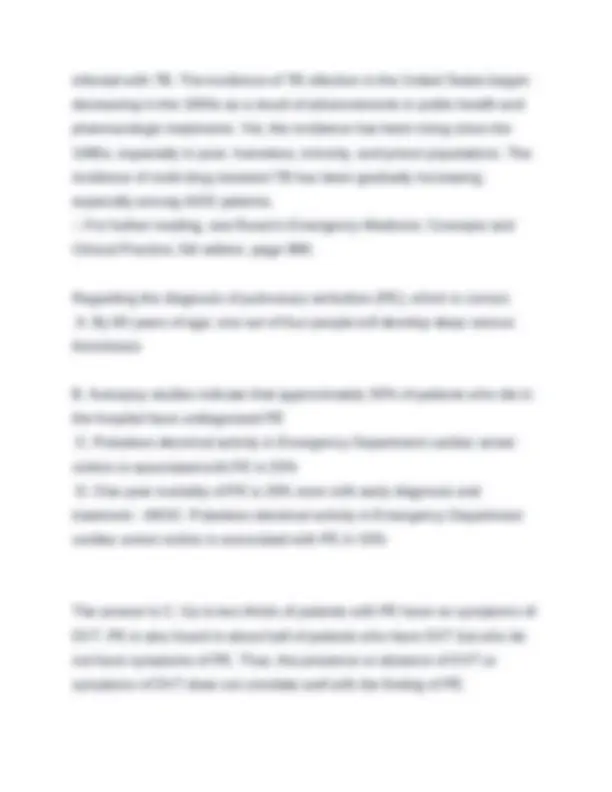
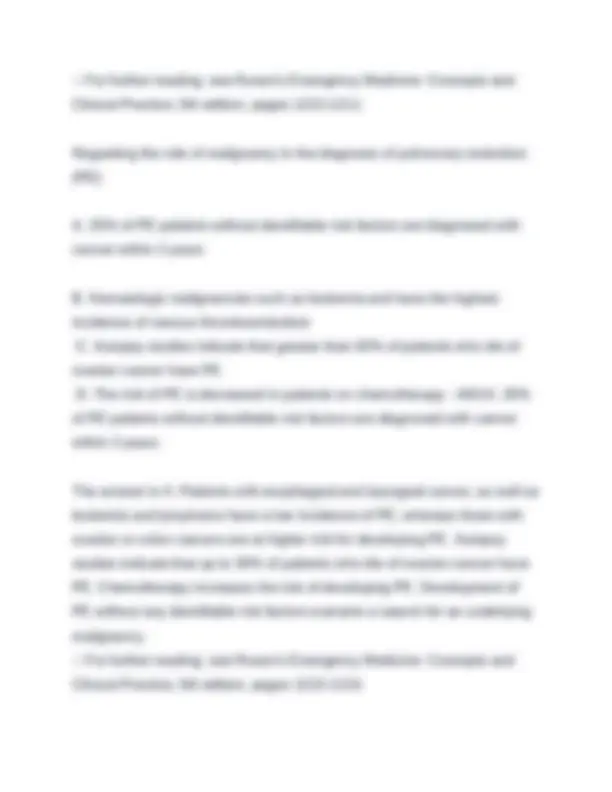

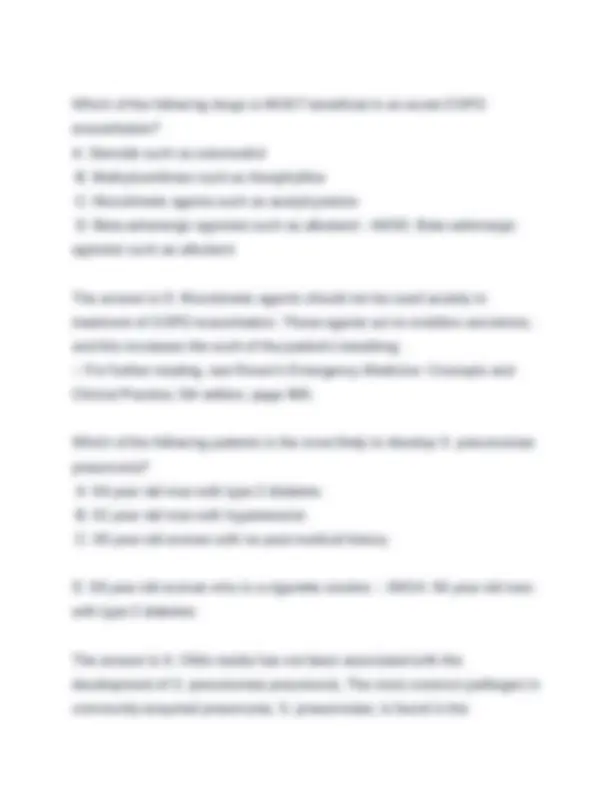
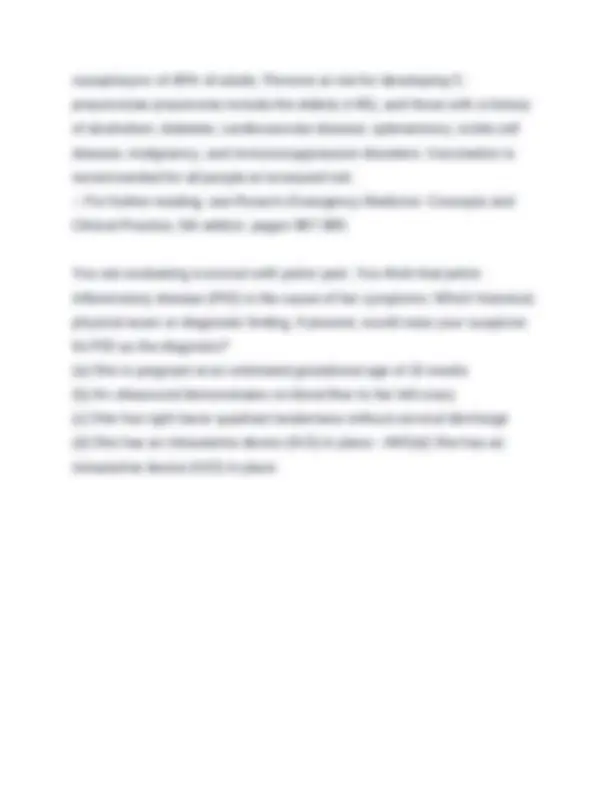


Study with the several resources on Docsity

Earn points by helping other students or get them with a premium plan


Prepare for your exams
Study with the several resources on Docsity

Earn points to download
Earn points by helping other students or get them with a premium plan
Community
Ask the community for help and clear up your study doubts
Discover the best universities in your country according to Docsity users
Free resources
Download our free guides on studying techniques, anxiety management strategies, and thesis advice from Docsity tutors
SAEM 510-547 Real Exam Test Bank. Questions & Correct Verified Answers. Updated Versions 2025-2026. Graded A
Typology: Exams
1 / 23

This page cannot be seen from the preview
Don't miss anything!
















A 17 year old male presents to the emergency department complaining of excruciating groin pain that woke him from sleep. This pain is associated with nausea and radiation into the abdomen. On examination his right testicle is firm, exquisitely tender, and there is unilateral absence of the cremasteric reflex. A bedside diagnostic and therapeutic maneuver would be to: (a) Elevate the left testicle (b) Rotate his right testicle in a medial to lateral rotation (540 degrees) (c) Perform a bedside scrotal ultrasound (d) Transilluminate the right testicle - ANS(b) Rotate his right testicle in a medial to lateral rotation (540 degrees) A 17 year old male presents to the emergency department complaining of excruciating groin pain that woke him from sleep. This pain is associated with nausea and radiation into the abdomen. On examination his right testicle is firm, exquisitely tender, and there is unilateral absence of the cremasteric reflex. A bedside diagnostic and therapeutic maneuver would be to: A. Elevate the left testicle B. Rotate his right testicle in a medial to lateral rotation (540 degrees) C. Perform a bedside scrotal ultrasound
D. Transilluminate the right testicle - ANSB. Rotate his right testicle in a medial to lateral rotation (540 degrees) A 25 year old female presents with epigastric pain radiating straight through to the back. Laboratory tests are notable only for markedly elevated amylase and lipase. An abdominal X-ray is taken (see Figure). Regarding this patient's presentation, which of the following is most likely true? [picture of an xtra showing stones in the GB] (a) She probably has an ulcer, since the laboratory results are nonspecific. (b) Alcohol use is only associated with pancreatitis in patients older than this woman, and who have been abusing alcohol for years. (c) The abdominal X-ray is concerning for early bowel obstruction. (d) The X-ray reveals that intrathoracic pathology is likely the cause of the patient's symptoms. (e) The most likely explanation for her symptoms is gallstone-related pancreatitis. - ANS(e) The most likely explanation for her symptoms is gallstone-related pancreatitis. The answer is E. The X-ray reveals stones in the gallbladder. These particular stones are not likely the cause of pancreatitis, but the demonstration of gallstone disease raises the likelihood that the patient's pancreatitis is indeed due to gallstones. In the U.S., the most common etiologies of pancreatitis include gallstones (45%) and alcoholism (35%). Alcoholic pancreatitis may occur in young patients as well as in older abusers of alcohol. Many other drugs, infectious agents, and conditions are associated with the development of pancreatitis. A few examples include
tender, ecchymotic and tense calf with small bullae forming near the bite. There are preserved pulses and paresthesias in his foot. There is intense pain with passive ranging of the ankle. Which of the following is the most appropriate management of this patient's condition? (a) Immediate administration of the FabAV antivenin with ICU admission and surgical consult (b) Immediate application of a proximal tourniquet to prevent systemic spread of toxin, FabAV antivenin, and surgical consult in the Emergency department (c) IV mannitol and elevation of the extremity with ICU admission (d) Immediate decompressive fasciotomy in the OR, along with administration of FabAV antivenin - ANS(d) Immediate decompressive fasciotomy in the OR, along with administration of FabAV antivenin A 26 year old male presents with 24 hours of epigastric pain and chills. The patient states it was his birthday 36 hours ago and he drank more alcohol than he should have. He had multiple episodes of violent, severe retching and non-bilious vomiting that have resolved. The patient feels that he is progressively getting sicker and has lately had chills and rigors. On physical examination, the patient looks unwell with a heart rate of 125 beats per minute and blood pressure of 89/53 mm Hg. He has pain in his epigastrium, a crunching sound on auscultation of his lungs, and subcutanesous emphysema. Which of the following is correct with regards to this patient's condition? (a) Nasogastric tube insertion is contraindicated (b) Pleural effusions commonly develop on the right side (c) Most injuries occur in the distal esophagus
(d) Majority of cases are managed non-operatively - ANS(c) Most injuries occur in the distal esophagus A 32 year old man is brought in by EMS after an acetylene torch exploded in his hands. He was not wearing a mask and his entire face, chest, arms and hands are blackened and blistering. All of the patient's hair in these areas has been burnt off. There are areas of skin missing from his hands and chest. He is awake and alert, crying out from pain. He is able to answer all questions appropriately. He demonstrates no stridor, lungs are clear to auscultation. Heart exam is significant for tachycardia. (a) Intubation for airway management (b) Antibiotic ointment to prevent infection (c) Silvadine dressings to soothe and promote rapid healing (d) Tepid, sterile water to cool and prevent ongoing burns - ANS(a) Intubation for airway management A 32 year old man is brought in by EMS after an acetylene torch exploded in his hands. He was not wearing a mask and his entire face, chest, arms and hands are blackened and blistering. All of the patient's hair in these areas has been burnt off. There are areas of skin missing from his hands and chest. He is awake and alert, crying out from pain. He is able to answer all questions appropriately. He demonstrates no stridor, lungs are clear to auscultation. Heart exam is significant for tachycardia. What is your immediate management? (a) Silvadine dressings to soothe and promote rapid healing (b) Tepid, sterile water to cool and prevent ongoing burns (c) Antibiotic ointment to prevent infection
D. Discharge home with daily ED wound checks and oral antibiotics - ANSC. Intensive care unit with IV antibiotics A 45 year old female patient presents to the emergency department in the care of her husband with a complaint of agitation and anxiety. Her husband states that she has been acting "strangely" for the past several days. She's been hyperactive, "agitated", and sometimes delusional. She is previously healthy but has allergies to penicillins, iodine, and morphine. On exam, the patient is clearly anxious and frustrated with the visit. She's diaphoretic and on cardiovascular exam a harsh systolic murmur is heard as well as an irregularly irregular rhythm. Vital signs show a temperature of 101.5, HR 123, BP 175/98, RR 27, and SpO2 98% on RA. An EKG shows rapid atrial fibrillation. What is the definitive treatment for her condition? (a) Diltiazem, benzodiazepines, IV fluids (b) Aspirin, benzodiazepines, fluids (c) Lithium, propranolol, acetaminophen (d) Acetaminophen, haloperidol, atenolol - ANS(c) Lithium, propranolol, acetaminophen A 45 year old male alcoholic presents to the ED with syncope and recent alcohol use. He denies any pain except for some "dark diarrhea", and feels anxious. He was told that he may have "liver problems" but has never followed up. His triage vital signs show a pulse of 128, RR 28, BP 88/52, Temp 98.8F. While you are presenting his history to the attending physician, a nurse calls you in because the patient is vomiting copious amounts of coffee-colored emesis mixed with bright blood. He is losing
consciousness and acting confused. After the placement of 2 large bore IV's, Isotonic fluids are hung wide open, and blood is ordered. (a) Intubation (b) CT scan of abdomen/pelvis (c) Sedation for endoscopy (d) IR consult for TIPS procedure - ANS(a) Intubation A 47 year-old male presents, confused, to the ED. He has limited ability to give a history. On physical examination of the skin, it is noted that there are erythematous changes to both palms. Also, the face and arms are characterized by a number of superficial, tortuous arterioles which fill from the center outwards. The examination of the abdomen reveals violaceous lines radiating from the umbilicus, and there are generally increased venous markings on the abdominal wall (see Figure). What is the most likely diagnosis? [picture of a jaundiced dude with caput medusae] (a) necrotizing fasciitis (b) Rocky Mountain spotted fever (c) lymphangitis (d) hyperthermia (e) liver disease - ANS(e) liver disease The answer is E. The patient's palmar erythema, spider angiomata, and caput medusa (due to recanalization of the umbilical vein) are all characteristic of hepatic disease. The figure demonstrates abdominal wall venous engorgement, as well as ascites (another clue to the patient's liver disease).
-- For further reading, see Rosen's Emergency Medicine: Concepts and Clinical Practice, 6th edition, pages 1414-1417. A 57-year-old homeless woman with a history of schizophrenia presents to the emergency department complaining of nausea and severe abdominal pain for 48 hours. The patient is not cooperative with an upright abdominal image, so a flat plate (as shown in the Figure) is obtained. Which of the following is the most likely operative finding in this patient? (a) Inflamed appendix (b) Rectus sheath hematoma (c) Ruptured spleen (d) Small bowel obstruction - ANS(d) Small bowel obstruction The answer is D. Dilated loops of small bowel with air-fluid levels (which are not well-seen on a flat plate) indicate small bowel obstruction. KUB is not often useful in the diagnosis of appendicitis, ruptured spleen, gallstone disease, or a rectus sheath hematoma (which is an abdominal wall condition most likely seen in anticoagulated patients with trauma or coughing). Despite this woman's history of schizophrenia and possibly diminished ability to relate a clear story of her pain, her complaint of abdominal pain must be taken seriously with a high suspicion for underlying pathology. -- For further reading, see Rosen's Emergency Medicine: Concepts and Clinical Practice 6th edition, page 1442.
A 58 year old male with a past medical history significant for more than 30 pack years of tobacco use and recently diagnosed COPD presents to the emergency department with an episode of shortness of breath and increased sputum production for the last several days, which became acutely worse overnight. Which of the following findings would make the patient a good candidate for initiation of noninvasive positive pressure ventilation? A. hemodynamic instability B. noncompliant with face mask for oxygen supplementation C. markedly increased airway secretions D. hypoxia refractory to initial management - ANSD. hypoxia refractory to initial management A 62 year-old female with a history of congestive heart failure presents after a family picnic with worsening shortness of breath. This is exacerbated by walking or lying in the recumbant position. Her blood pressure is 150/80, heart rate 90, respiratory rate is 24, temperature is 98oF and pulse oximetry reads 88%. She speaks in broken sentences. She has JVD to the angle of the mandible and her trachea is midline. Her lungs have symmetrically decreased air movement with crackles halfway up. What is the best way to support her breathing while waiting for medications to take effect? (a) Oxygen delivered by nasal cannula (b) Bilevel positive pressure ventilation (c) Needle thoracostomy (d) Intubation and mechanical ventilation - ANS(b) Bilevel positive pressure ventilation
(c) An antibiotic such as doxycycline (d) A mucokinetic such as guaifenesin - ANS(c) An antibiotic such as doxycycline A 65 year old male with a history of COPD presents to the emergency department with increasing dyspnea, rhinorrhea, cough, and sputum production over the last three days. He denies fever or chest pain. His last acute health visit was 6 months ago. His vital signs are as follows: BP 135/75, HR 85, RR 19, SpO2 95%, Oral temp 98.0 °F. His exam is significant for a diffuse expiratory wheeze and prolonged expiratory time. His chest X-ray and EKG are unchanged from baseline and your patient responds to your ED medical therapy. In addition to an inhaled beta agonist your patient's recommended outpatient pharmacotherapy includes: A. A methylxanthine such as theophyline B. A high-dose oral corticosteroid such as prednisone C. An antibiotic such as doxycycline D. A mucokinetic such as guaifenesin - ANSC. An antibiotic such as doxycycline A 74 year old cancer patient presents to the ED for labored breathing. You arrive in the room and see a patient with significantly labored breathing in a tripod position, speaking in short sentences, who says "I...just...can't...catch my breath!" Vital signs are obtained and show a HR of 113 bpm, BP of 90/43, SpO2 95% on 2L by nasal cannula, RR 34, temp 98.4F. On exam, lung sounds are clear bilaterally with good inspiratory effort, heart sounds are present but quiet, distended neck veins, and there is no peripheral edema. What test is most likely to confirm your suspected diagnosis?
(a) D-dimer (b) EKG (c) Bedside cardiac ultrasound (d) Chest radiography - ANS(c) Bedside cardiac ultrasound A 78 year old female presents to the E.D. with a sensation of left-lower quadrant abdominal pain, accompanied by some irregular bowel movements and loss of appetite. Her abdominal CT (two images) is shown in the Figure. What is the most likely diagnosis? (a) diverticulitis (b) ovarian cyst (c) volvulus (d) appendicitis (e) gastroenteritis - ANS(a) diverticulitis A blunt trauma patient presents, transported by EMS from a motor vehicle collision, with inability to provide a history, due to alcohol intoxication. He has no signs of trauma on external evaluation, but he is hypotensive. An ED ultrasound is performed at the bedside, and is depicted in the figure. Given the patients' clinical condition and image seen, what is the most likely diagnosis? (a) Ruptured gallbladder (b) Rupturing abdominal aortic aneurysm (c) Fat embolus from femur fracture (d) Free intraabdominal fluid - ANS(d) Free intraabdominal fluid The answer is D.
A. Right bundle branch block indicates pulmonary infarction from PE. B. Tachycardia is the most common finding of EKG associated with PE. C. A pattern of diffuse PR depression suggests PE D. An S1Q3T3 pattern is pathognomonic for PE. - ANSB. Tachycardia is the most common finding of EKG associated with PE. The answer is B. Tachycardia and non-specific ST-segment and T-wave abnormalities are the most common findings on EKG of patients with PE; however up to 25% will have EKGs unchanged from their baselines. An S1- Q3-T3 pattern is suggestive but not diagnostic of PE. Right bundle branch block may also be seen in PE, but does not indicate pulmonary infarction or severity of PE. Diffuse PR depression is typically seen in pericarditis. -- For further reading, see Rosen's Emergency Medicine: Concepts and Clinical Practice, 5th edition, page 1225. A radiographic finding that may be seen in an elderly patient who aspirated food is: A. An opacity in the right middle lobe bronchus B. Tension pneumothorax on the right, with leftward mediastinal shift C. Hyperinflation of the left lung D. Visualization of the food bolus in the right mainstem bronchus - ANSC. Hyperinflation of the left lung
The answer is C. Due to its wider diameter and the fact it forms a more obtuse take-off angle with the trachea, the right mainstem bronchus is a more likely site of aspiration than the left mainstem bronchus in adults. On chest X-ray, aspiration is more likely to be detected because of secondary signs, such as hyperinflation or atelectasis of the involved lung, rather than direct visualization of the aspirated contents. In this clinical scenario, the adult patient may have aspirated food into the right mainstem bronchus. One would therefore expect either atelectasis (collapse) or hyperinflation on the right side. The lobar bronchus to the right middle lobe has an acute take-off angle and poor collateral ventilation, which make it prone to atelectasis. Thus, it is the part of the right lung most likely to exhibit atelectasis after an aspiration event. -- For further reading, see Rosen's Emergency Medicine: Concepts and Clinical Practice, 5th edition, Chapter 53. An unconscious 8 year old boy was pulled out of a freshwater lake. It was unknown how long he had been submerged in the water or how much water he had aspirated. The water temperature was 20C at the time he was pulled out of the water. He was found to be hypoxic upon removal and quickly given 100% oxygen. Which of the following is correct with regards to this drowning scenario? (a) Adults develop hypothermia more quickly than children in cold water (b) Initial treatment of fresh water and salt water drowning are different (c) Hypoxia is based on volume of water aspirated and not water content (d) Significant ingestion of freshwater will cause hypernatremia - ANS(c) Hypoxia is based on volume of water aspirated and not water content
infected with TB. The incidence of TB infection in the United States began decreasing in the 1950s as a result of advancements in public health and pharmacologic treatments. Yet, the incidence has been rising since the 1980s, especially in poor, homeless, minority, and prison populations. The incidence of multi-drug resistant TB has been gradually increasing, especially among AIDS patients. -- For further reading, see Rosen's Emergency Medicine: Concepts and Clinical Practice, 5th edition, page 988. Regarding the diagnosis of pulmonary embolism (PE), which is correct. A. By 80 years of age, one out of four people will develop deep venous thrombosis B. Autospsy studies indicate that approximately 30% of patients who die in the hospital have undiagnosed PE C. Pulseless electrical activity in Emergency Department cardiac arrest victims is associated with PE in 33% D. One-year mortality of PE is 25% even with early diagnosis and treatment - ANSC. Pulseless electrical activity in Emergency Department cardiac arrest victims is associated with PE in 33% The answer is C. Up to two-thirds of patients with PE have no symptoms of DVT. PE is also found in about half of patients who have DVT but who do not have symptoms of PE. Thus, the presence or absence of DVT or symptoms of DVT does not correlate well with the finding of PE.
-- For further reading, see Rosen's Emergency Medicine: Concepts and Clinical Practice, 5th edition, pages 1210-1211. Regarding the role of malignancy in the diagnosis of pulmonary embolism (PE): A. 25% of PE patients without identifiable risk factors are diagnosed with cancer within 2 years. B. Hematologic malignancies such as leukemia and have the highest incidence of venous thromboembolism C. Autopsy studies indicate that greater than 60% of patients who die of ovarian cancer have PE. D. The risk of PE is decreased in patients on chemotherapy - ANSA. 25% of PE patients without identifiable risk factors are diagnosed with cancer within 2 years. The answer is A. Patients with esophageal and laryngeal cancer, as well as leukemia and lymphoma have a low incidence of PE, whereas those with ovarian or colon cancers are at higher risk for developing PE. Autopsy studies indicate that up to 30% of patients who die of ovarian cancer have PE. Chemotherapy increases the risk of developing PE. Development of PE without any identifiable risk factors warrants a search for an underlying malignancy. -- For further reading, see Rosen's Emergency Medicine: Concepts and Clinical Practice, 5th edition, pages 1215-1216.